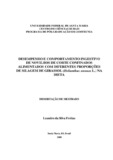| dc.creator | Freitas, Leandro da Silva | |
| dc.date.accessioned | 2017-07-06 | |
| dc.date.available | 2017-07-06 | |
| dc.date.issued | 2008-02-19 | |
| dc.identifier.citation | FREITAS, Leandro da Silva. Performance and ingestive behavior of feedlot steers fed with different diet proportions of sunflower silage (Helianthus annuus L.). 2008. 82 f. Dissertação (Mestrado em Zootecnia) - Universidade Federal de Santa Maria, Santa Maria, 2008. | por |
| dc.identifier.uri | http://repositorio.ufsm.br/handle/1/10708 | |
| dc.description.abstract | The objective of the present study was to evaluate the effect of diet substitution of
maize silage by sunflower silage on performance and ingestive behavior of feedlot steers.
Nine steers, with average initial live weight and age of 288 kg and 20 months, respectively,
from Nellore (N), 21/32Charolais (C) 11/32N and 21/32N 11/32C genetic groups, were used.
The tested diets were: SG0= roughage with 100% of maize silage and 0% of sunflower silage;
SG33= roughage with 67% of maize silage and 33% of sunflower silage and SG66= roughage
of 34% of maize silage and 66% of sunflower silage. For all diets, the roughage:concentrate
ratio used was of 60:40. The substitution of maize silage by sunflower silage didn t influence
(P>.05) dry matter, neutral and acid detergent fiber and digestible energy intakes. A
significant difference (P<.05) was observed for ether extract, being the higher value for SG66
(.83kg/day), the intermediary for SG33 (.63 kg/day) and the lower for SG0 (.50 kg/day). The
slaughter weight, average daily weight gain, final body condition, feed and energetic
conversions weren t influenced (P>.05) by treatments. Steers fed with SG66 stayed more time
ruminating (P<.05) in relation to SG33 and SG0 animals, being values of 9.45; 8.76 and 8.61
h, respectively for SG66; SG33 and SG0. Animals fed with SG0 presented better (P<.05) dry
matter and detergent fiber rumination. The time spending with feeding was higher (P<.05) for
SG0 (32.58 min), intermediary for SG33 (28.33 min) and lower for SG66 (23.46 min). | eng |
| dc.description.sponsorship | Conselho Nacional de Desenvolvimento Científico e Tecnológico | |
| dc.format | application/pdf | por |
| dc.language | por | por |
| dc.publisher | Universidade Federal de Santa Maria | por |
| dc.rights | Acesso Aberto | por |
| dc.subject | Consumo | por |
| dc.subject | Extrato etéreo | por |
| dc.subject | Ócio | por |
| dc.subject | Ruminação | por |
| dc.subject | Volumoso | por |
| dc.subject | Ether extract | eng |
| dc.subject | Idle | eng |
| dc.subject | Intake | eng |
| dc.subject | Roughage | eng |
| dc.subject | Rumination | eng |
| dc.title | Desempenho e comportamento ingestivo de novilhos de corte confinados alimentados com diferentes proporções de silagem de girassol (Helianthus annuus l.) na dieta | por |
| dc.title.alternative | Performance and ingestive behavior of feedlot steers fed with different diet proportions of sunflower silage (Helianthus annuus L.) | eng |
| dc.type | Dissertação | por |
| dc.description.resumo | O objetivo do presente estudo foi avaliar a substituição da silagem de milho por silagem de girassol na dieta, através do desempenho e do comportamento ingestivo de
novilhos confinados. Foram utilizados nove novilhos castrados, com peso vivo e idade média inicial de 288 kg e 20 meses, respectivamente, pertencentes aos grupos genéticos Nelore,
21/32Charolês (C) 11/32Nelore (N) e 21/32N 11/32C. As dietas testadas foram: SG0= volumoso com 100% de silagem de milho e 0% de silagem de girassol; SG33= volumoso com
67% de silagem de milho e 33% de silagem de girassol e SG66= volumoso com 34% de silagem de milho e 66% de silagem de girassol. A relação volumoso:concentrado utilizada foi 60:40 para todas as dietas. A substituição da silagem de milho por girassol não influenciou (P>0,05) o consumo de matéria seca, de fibra detergente neutro e ácido, de energia digestível. Houve diferença (P<0,05) no consumo de extrato etéreo, sendo maior para SG66 (0,83 kg/dia), intermediário para SG33 (0,63 kg/dia) e menor para SG0 (0,50 kg/dia). O peso de abate, o ganho de peso médio diário, o estado corporal final, a conversão alimentar e energética não foram influenciados (P>0,05) pelos tratamentos. Os novilhos alimentados com SG66 ruminaram por mais (P<0,05) tempo em relação aos animais que receberam SG33 e SG0, sendo os valores de 9,45; 8,76 e 8,61 h, respectivamente, para SG66; SG33 e SG0. Animais alimentados com SG0 apresentaram melhor (P<0,05) de ruminação da matéria seca e da fibra em detergente. O tempo de despendido por refeição foi maior (P<0,05) para SG0 (32,58 min), intermediário para o SG33 (28, 33 min) e menor para SG66 (23,46 min). | por |
| dc.contributor.advisor1 | Silva, José Henrique Souza da | |
| dc.contributor.advisor1Lattes | http://lattes.cnpq.br/9107885158463694 | por |
| dc.contributor.referee1 | Lançanova, José Antônio Cogo | |
| dc.contributor.referee1Lattes | http://lattes.cnpq.br/1547140786044270 | por |
| dc.contributor.referee2 | Brondani, Ivan Luiz | |
| dc.contributor.referee2Lattes | http://lattes.cnpq.br/5813089147720195 | por |
| dc.creator.Lattes | http://lattes.cnpq.br/1152835050307149 | por |
| dc.publisher.country | BR | por |
| dc.publisher.department | Zootecnia | por |
| dc.publisher.initials | UFSM | por |
| dc.publisher.program | Programa de Pós-Graduação em Zootecnia | por |
| dc.subject.cnpq | CNPQ::CIENCIAS AGRARIAS::ZOOTECNIA | por |


